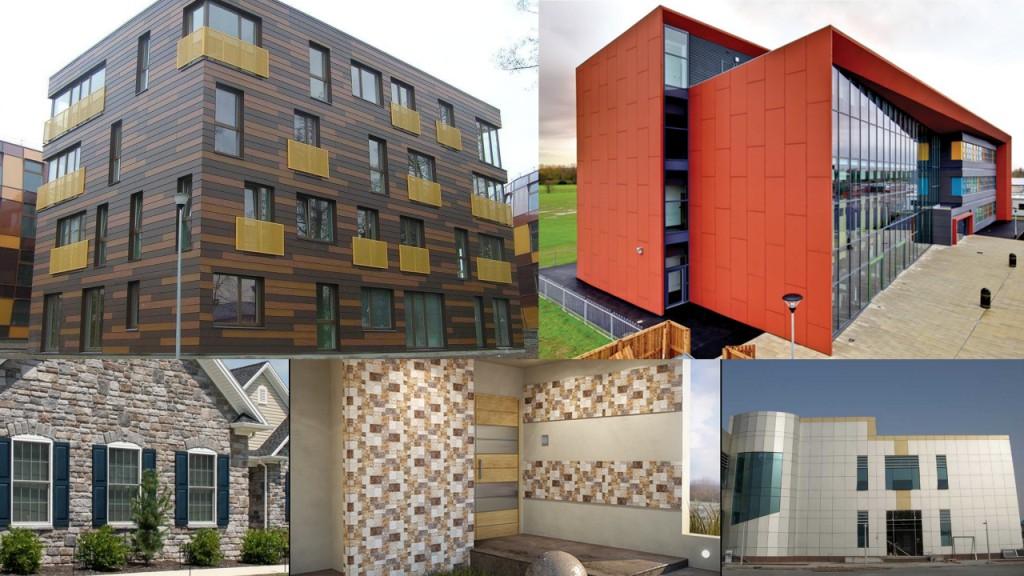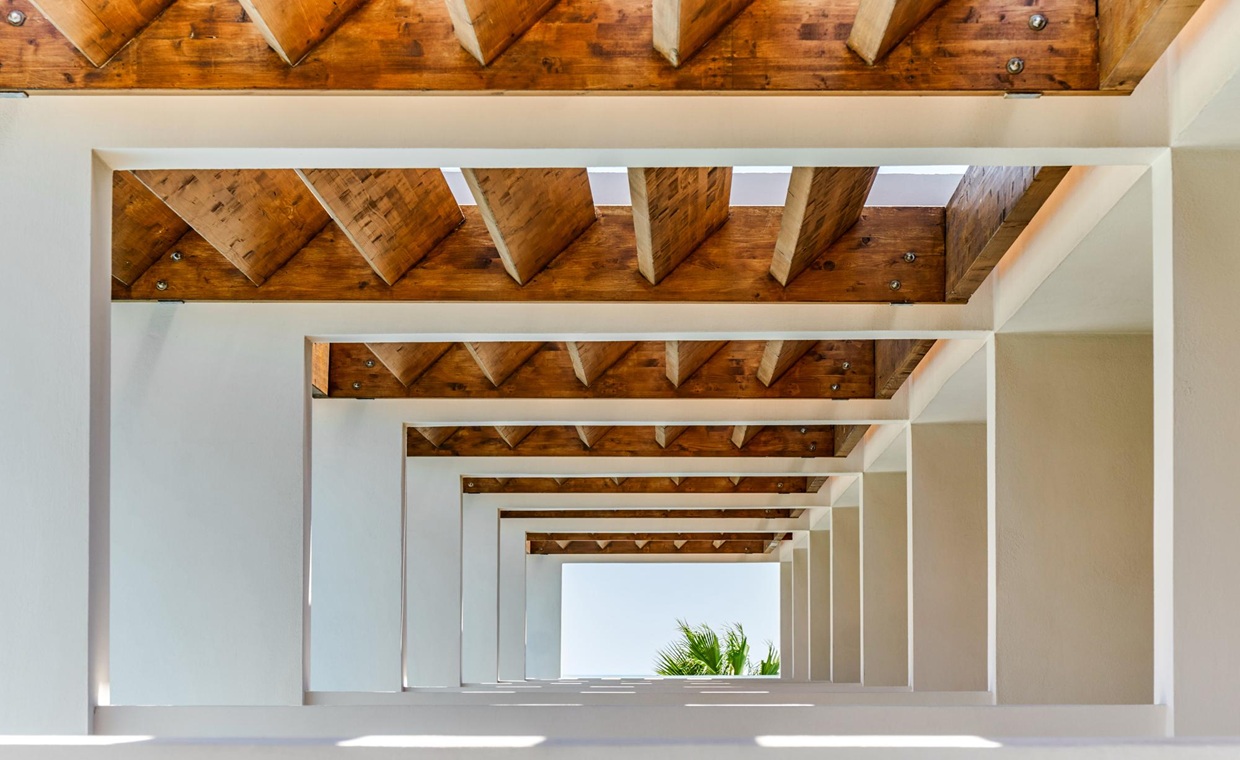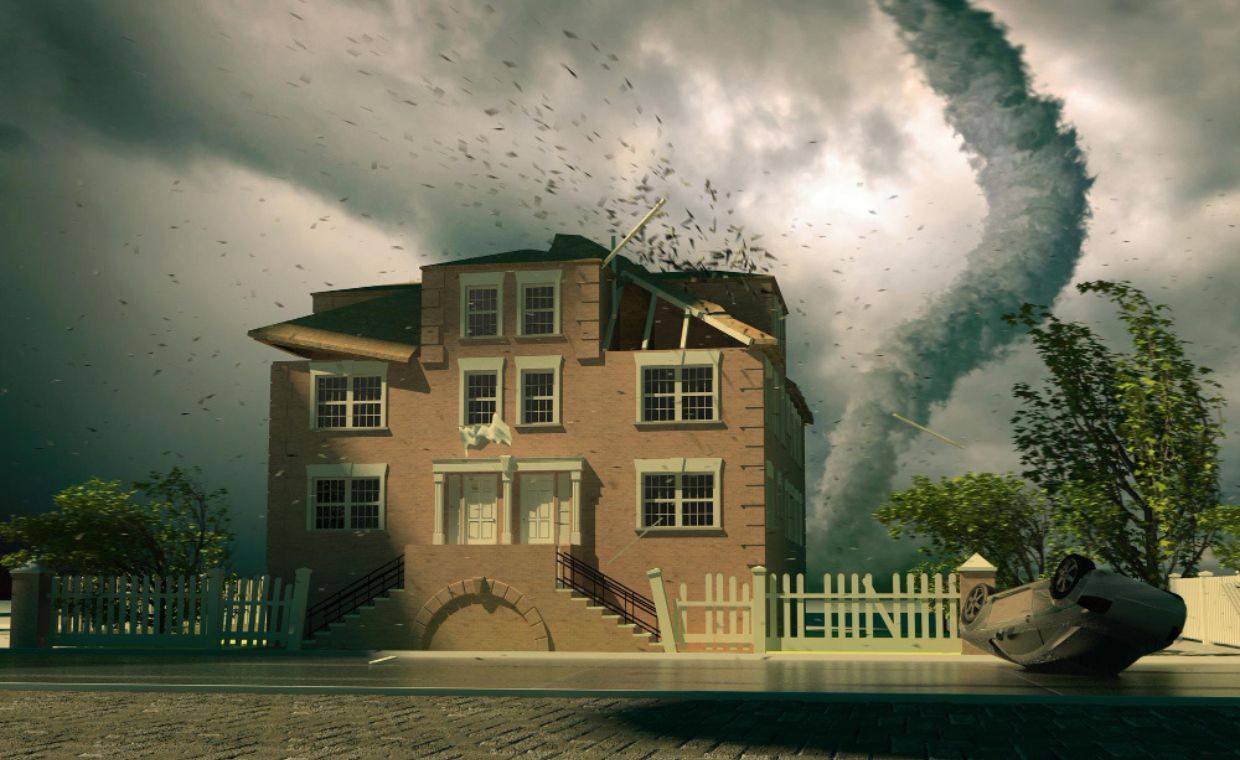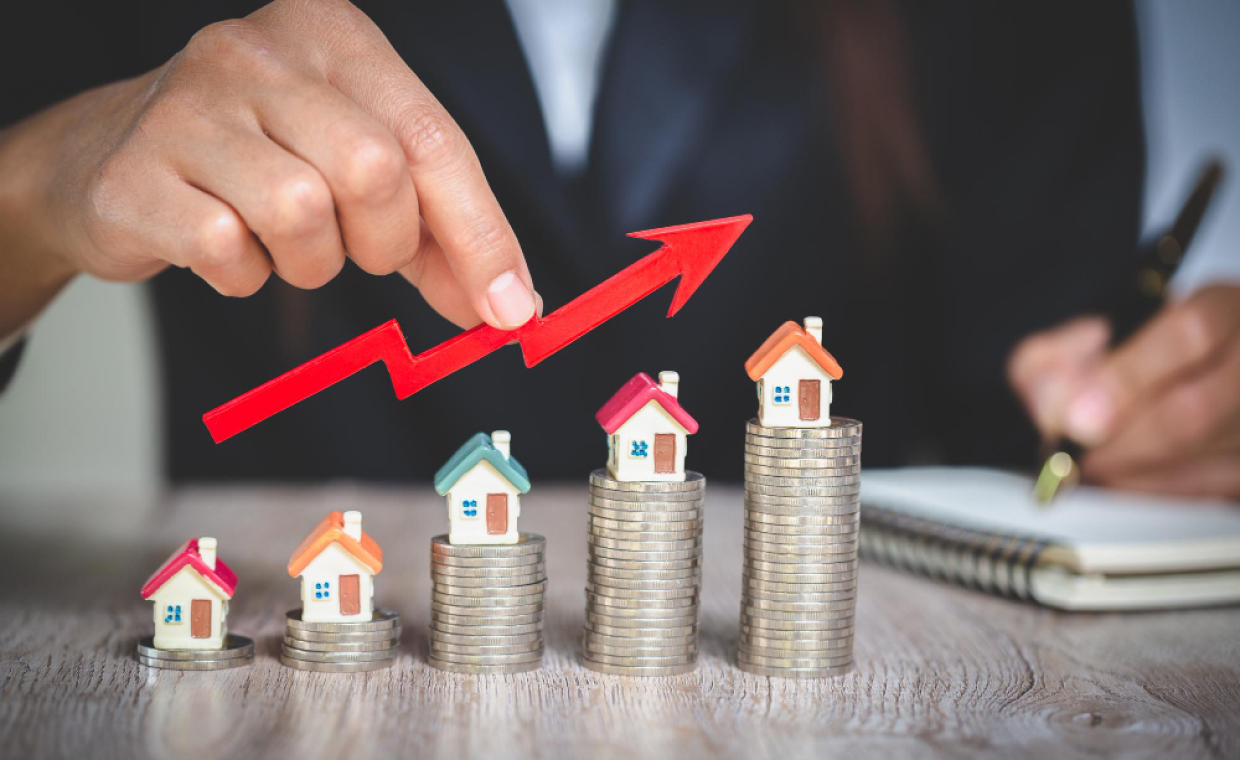
Cladding on the exterior walls of the home is nowadays becoming very popular due to its inherent advantages. Cladding helps in protecting the house from weather and increases its aesthetic value. There are different types of cladding materials available in the market such as aluminium composite panels, high pressure laminate, glass, natural stones, vitrified tiles, wood, fiber cement boards and many more.
Every wall cladding material has its own unique characteristics. Hence, one may get confused when while comparing these materials. Here we have given a brief comparison of cladding materials that are popularly used. The comparison of cladding materials will help the homeowner to select the right choice for their home.

Image Courtesy – Alcobond, Home.interfacelimited, City-glass, Goclward, Nicotiles
Comparison of Cladding Materials
01. Material Description
Aluminium Composite Panels
- Aluminium composite panels are made by using two sheets of aluminium attached to a plastic core.
High Pressure Laminate
- High Pressure Laminate is made from Kraft paper combined with resins and pressed at very high pressure to form compact sheets.
Fiber Cement Boards
- Fiber cement boards are made by reinforcing cement with cellulose fibers.
Natural Stone
- Stone cladding is made of a thin layer of natural stone applied to the walls.
Vitrified Tiles
- Vitrified tiles are composed of a mixture containing clay, silica, feldspar, quartz, which when heated at high temperature, is fused together, and glass type product is produced.
02. Texture/Finish
Aluminium Composite Panels
- Aluminium composite panels come in the smooth finish in various designs and colours such as wood, stone, etc.
High Pressure Laminate
- It comes in the smooth finish of various designs and colours such as wood, stone, metal, etc.
Fiber Cement Boards
- It comes in the smooth finish of various designs and colors such as wood, stone, metal, etc.
Natural Stone
- It comes in varying finishes of natural stone, the texture of each may also vary. Hence the cladded surface might exhibit such natural variation.
Vitrified Tiles
- Vitrified tiles come in a variety of designs and colors, with finishes of wood, stone, metal, etc. and given the uniform appearance.
03. Panel Size
Aluminium Composite Panels
- They are available in panels of standard size of 2440 mm X 1220 mm.
High Pressure Laminate
- They are available in panels of standard size of 2440 mm X 1220 mm.
Fiber Cement Boards
- They are available in panels of standard size of 2440 mm X 1220 mm.
Natural Stone
- They are available in standard units of size 300 mm X 300 mm or 600 mm X 600 mm.
Vitrified Tiles
- They are available in standard units of size 300 mm X 600 mm and also in 600 mm X 600 mm.
04. Method of Fixing
Aluminium Composite Panels
- All independent panels are separate and screwed on aluminium tubes.
High Pressure Laminate
- All independent panels are separate and screwed on aluminium tubes.
Fiber Cement Boards
- All independent panels are separate and screwed on aluminium tubes.
Natural Stone
- Special adhesives are used in fixing the units of the stone to the walls if wet cladding is adopted. Dry cladding can also be used. Here, bolts and clips are used to hold stones to provide mechanical anchorage, and also be fixed on aluminum tubes.
Vitrified Tiles
- Special tile adhesives are used in fixing the tiles to the walls. Bolts and clips are used to hold tiles including fixing aluminum tubes but in that case, you need minimum 8 to 12mm thickness of tiles.
05. Thickness and Weight
Aluminium Composite Panels
- They are available in thickness ranging from 3 to 6 mm. The standard weight of aluminium composite panel is 1250 kg/m3 and hence have less weight.
High Pressure Laminate
- They are available in thickness ranging from 6 to 12 mm. The standard weight of high pressure laminate is 1000 kg/m3 and thus have moderate weight.
Fiber Cement Boards
- They are available in thickness ranging from 4 to 22 mm. The standard weight of fibre cement boards is 1800 kg/m3 and thus have moderate weight if less thickness.
Natural Stone
- They are available in thickness ranging from 12 to 20 mm. The standard weight of natural stone is 2500 kg/m3 and hence have heavy weight.
Vitrified Tiles
- They are available in thickness ranging from 6 to 12 mm. The standard weight of vitrified tiles is 1500 to 2000 kg/m3 and hence have moderate weight.
06. Possibility of Breakage due to Earthquake
Aluminium Composite Panels
- Being light in weight, and due to the method of fixing they are less likely to fall during shaking, and not likely to get injured.
High Pressure Laminate
- Being light in weight, and due to the method of fixing they are less likely to fall during shaking, and not likely to get injured.
Fiber Cement Boards
- They are fixed using screws but due to their heavy weight may fall during an earthquake, but if screwed adequately, it may not!
Natural Stone
- The stones may fall during an earthquake as they are fixed using an adhesive. Even in case of dry cladding, they may fall as they are brittle. Being brittle in nature, individual piece may also break and fall though sticking is good.
Vitrified Tiles
- The tiles may fall off the surface during an earthquake. They brittle in nature as otherwise also some bad piece may break or fall.
07. Thermal Insulation
Aluminium Composite Panels
- The thermal conductivity of aluminium composite panel is 0.15 – 0.1 W/m/ 0K and hence they have good thermal insulation.
High Pressure Laminate
- The thermal conductivity of high pressure laminate is 0.2 – 0.5 W/m/ 0K and hence they have moderate thermal insulation.
Fiber Cement Boards
- The thermal conductivity of fiber cement board is 0.15 – 0.21 W/m/ 0K and hence they have moderate thermal insulation.
Natural Stone
- Depending upon the stone the thermal conductivity may vary from 0.2 to 2.7 W/m/ 0K.
Vitrified Tiles
- The thermal conductivity of vitrified tiles is 0.6 – 1.7 W/m/ 0K. They have low thermal insulation and hence can easily transmit heat or cold from outside to the interior of the house.
08. Resistance Against Rain or Storm
Aluminium Composite Panels
- If proper waterproofing is not done, aluminium composite panels may become weak against rain.
High Pressure Laminate
- They have good resistance against rain; hence, they are not affected due to rain.
Fiber Cement Boards
- They have good resistance against rain. They may become wet by absorbing moisture.
Natural Stone
- They have good resistance towards rain; hence, they are not affected due to rain. They are porous in nature and hence their colour may change temporarily.
Vitrified Tiles
- They have high resistance towards rain; hence, they are not affected due to rain.
09. Resistance Against UV Rays (Fading of Color)
Aluminium Composite Panels
- Fading of color normally occurs after a certain period. Initially, it was a popular cladding material, but due to fading of color, it has become unpopular.
High Pressure Laminate
- Fading of color may occur after a certain period.
High Pressure Laminate
- Fading of color may occur after a certain period.
Fiber Cement Boards
- Fading of color may occur after a certain period.
Natural Stone
- As they are made from natural material, over prolonged exposure to UV rays, there may be less fading of colour.
Vitrified Tiles
- As they have a glass like reflection properties, there are less chances of fading of colour of vitrified tiles.
10. Resistance Against Fire
Aluminium Composite Panels
- They have less resistance against fire. Nowadays fire rated panels are also available.
High Pressure Laminate
- High pressure laminate has less resistance towards fire and is combustible.
Fiber Cement Boards
- As cement is one of the major ingredients, fiber cement boards are incombustible and have high resistance towards fire.
Natural Stone
- Natural stone have high resistance against fire and are incombustible, but when heated may become brittle and fall.
Vitrified Tiles
- Vitrified tiles have high resistance against fire and are incombustible, but may fall due to heating.
11. Expansion and Contraction due to Temperature Change
Aluminium Composite Panels
- Joints between panels will have to be provided which will be filled by waterproof sealants.
High Pressure Laminate
- Joints between panels will have to be provided which will be filled by waterproof sealants.
Fiber Cement Boards
- It is more dimensionally stable as compared to wood, but still small joints are to be provided. The joints are filled with sealants.
Natural Stone
- Natural stones are dimensionally stable and hence do not require any joints. However, small joints may be required for levelling of the stones.
Vitrified Tiles
- Joints will have to be provided which will be filled by sealants
All panels will have to be provided with joints so as to take care of expansion and contraction due to temperature change.
12. Maintenance and Cleaning
Aluminium Composite Panels
- The panels will need periodical cleaning to clean the dust accumulated on its surface.
High Pressure Laminate
- High pressure laminate will need some periodical cleaning to clean the dust accumulated on its surface.
Fiber Cement Boards
- Fiber cement boards will need some periodical cleaning to clean the dust accumulated on its surface.
Natural Stone
- The natural stones will need more intensive cleaning as they have rough surface and dirt may be stuck to it.
Vitrified Tiles
- Vitrified tiles will need some periodical cleaning to clean the dust accumulated on its surface..
13. Durability
Aluminium Composite Panels
- Aluminium composite panels have to be replaced after 20 years and have less life.
High Pressure Laminate
- High pressure laminate has to be replaced after 25 years.
Fiber Cement Boards
- Fiber cement boards have to be replaced after 35 years.
Natural Stone
- They have the highest durability among the cladding materials. They can last 50 years or even more.
Vitrified Tiles
- Vitrified tiles hold good up to 15 to 25 years and then have to be replaced.
14. Cost
Aluminium Composite Panels
- Aluminium composite panels are costlier than high pressure laminates.
High Pressure Laminate
- They have the least cost among the cladding materials.
Fiber Cement Boards
- They are costlier as compared to aluminium composite panels, high pressure laminates. But may be cheaper than natural stone, high pressure laminate or vitrified tiles.
Natural Stone
- They are the most expensive among the cladding materials depending upon the type of stone and size.
Vitrified Tiles
- Vitrified tiles are cheap as compared to aluminium composite panel, but expensive than high pressure laminate.
Special Comment
Except natural stone, all other wall cladding materials are available in a variety of designs and colors. Natural stone has exceptional durability and gives the natural look to the walls. From the above comparison of cladding materials, a homeowner must make a judicious and rational choice according to his requirements.
Also Read:
All about Tile Installation & Its Precautions
Embossed Wallpaper: To Hide Defects on the Walls!
Cement Plaster: All You Need To Know!
Comparison of Red Bricks vs AAC Blocks vs Fly Ash Bricks vs Solid Concrete Blocks vs CLC Blocks


































